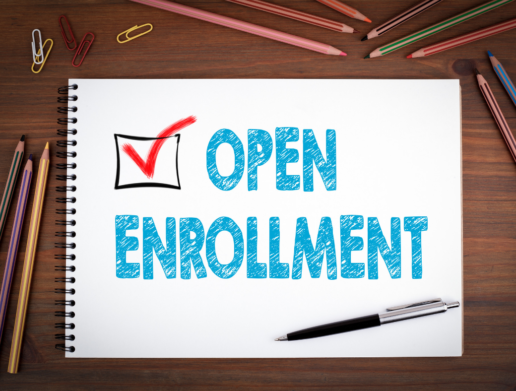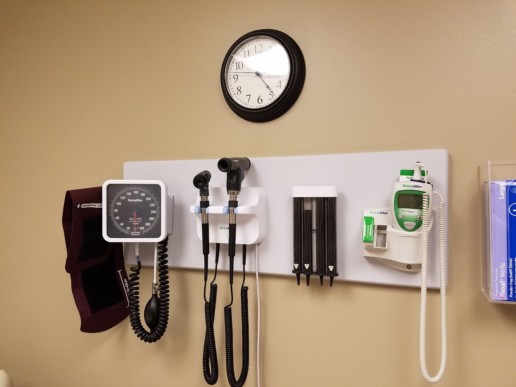Here's your employee checklist for open enrollment
The COVID-19 pandemic has focused consumer attention on health care, germs and the impact a single illness can have on their lives, livelihoods and loved ones. With the fall open enrollment season almost here, you have the opportunity to think more critically about the specific plans you choose for yourself and your family, as well as any voluntary benefits that may be available to you, including childcare, elder care and critical illness. In a world where it feels like health is out of the individual’s control, we all want, at the very least, to feel control over our coverage.
As we know all too well, there’s a lot to consider when it comes to choosing and using health care benefits. The most important piece of becoming an informed health care consumer is ensuring you have access to — and understand — the benefits information you need to make smart health care choices.
While open enrollment may seem daunting, devoting an hour or two to reviewing your plan options, the programs available to support you and your family physically, mentally and financially, and how to get the most from the coverages you do elect, can go a long way towards providing peace of mind as we face the unknowns of 2021. Here are five tips to keep in mind as you prepare for and participate in open enrollment.
Don’t forget that preventive care is covered by most plans at 100% in-network regardless of where that care is received. Schedule your appointments as soon as possible (and permissible in their area), and research other venues for receiving care, such as pharmacies, retail clinics and urgent care facilities. Most are equipped to provide standard vaccinations and/or routine physicals.
Unfortunately, there are also the long-term implications of COVID-19 to consider. Research suggests that there are serious health impacts that emerge in survivors of COVID-19, such as the onset of diabetes and liver, heart and lung problems. And many who were able to ride out the virus at home are finding it’s taking months, not weeks, to fully recover. As a result, you should prepre for the possibility that you, or a loved one, may be ill and possibly out of work for an extended period of time. Be sure to evaluate all of the plans and programs your employer offers to ensure your family has the financial protections you need. For some, a richer health plan with a lower deductible, voluntary plans such as critical illness or hospital indemnity insurance, and buy-up life and disability insurance may be worth investigating for the first time.
As hospitals reopen, it may be difficult to schedule a procedure due to scheduling requirements and pent up demand. A second opinion may be in order if your condition stabilized, improved or worsened during the delay; there may be other treatment options available.
A delay in scheduling also provides an opportunity to “shop around” for a facility that will provide needed care at an appropriate price — especially if you are choosing to go out-of-network or have a plan without a network. Researching cost is the best way to find the most affordable providers and facilities with the best quality, based on your specific needs.
Many medical plans offer second opinion and transparency services, and there are independent organizations who provide “white glove,” personalized support in these areas. Read over your enrollment materials carefully, or check your plan’s summary plan description, to see what your employer offers. If nothing is available, ask your employer to look into it, and don’t hesitate to do some research on your own. Doing so can often result in substantial cost savings, without compromising on quality of care.
Be sure to check up on your preferred health care providers — especially those you might not see regularly — to confirm they are still in business and still in network (if applicable). If you live in a rural area, you may have to travel farther to reach in-network facilities. If you’re currently covered by an HMO or EPO, you may want to evaluate whether that option still makes sense, if your preferred in-network providers are no longer available.
When was the last time you changed your medical plan? If you’ve been keeping the same coverage for years, it might be time to look at what else is available. Your employer may have introduced new plans, or you may find that a different plan makes more sense financially based on how often you need health care. Don’t forget — the cheapest plan isn’t always the one with the lowest premiums.
You may also want to consider setting aside funds in a health savings account or health care flexible spending account (if available). If your employer offers a wellness program, this might be an opportunity to start adopting better health habits to ensure you’re better equipped physically and mentally to deal with whatever lies ahead.
Tackle growing healthcare costs with earned wage access
As open enrollment begins to trickle in, advisors are looking for new and improved ways to help employees to leverage out of pocket costs on the year that is upon them. For both and employers and employees, healthcare strategies are an integral part of workforce management. Read this blog post to learn more.
It’s that time of year when we all learn that health care costs are going up (again).
As the nonprofit Business Group on Health reported, the average employee will be hit with $15,500 in out-of-pocket costs next year, and the average employer will pick up about two-thirds of that tab. Even with shared responsibility, those are big hits for both employer and worker, which is why health care strategy must be integral part of workforce management.
However, benefits managers may not be aware of a tool that may help keep health care costs down for both employers and workers, and which lets employees more fully participate in the economy they helped create.
Earned Wage Access (EWA), sometimes known as on-demand pay, is a revolutionary benefit that I wrote about back in May. It comes at no cost to employers, and is available to workers at little or even no cost, depending on the provider.
Earned Wage Access allows workers to access a portion of their earned wages that they have not yet been paid on. Depending on the provider, those wages can be immediately accessed on the provider’s payroll card, or just about any debit card.
What does on-demand pay have to do with health care?
When employees receive medical services, payment is often required up front. If employees only get their paycheck every two weeks, they may not have access to liquidity to pay for those services. The result is that an employee may be forced to delay a necessary visit or procedure, and if they are suffering from an acute condition, their health may be severely compromised.
However, with immediate access to the money employees have earned, but not yet been paid on, they have access to health care in the moment. Waiting rooms are bad enough. Waiting periods for basic health care are unnecessary and harmful.
There’s another reason why on-demand pay is critical to your health care strategy. There is a stealth health care crisis brewing in America. Millions have delayed preventative and necessary care due to the COVID-19 situation.
Every delayed preventative screening, test or check-up can result in a failure to discover a serious medical condition that requires treatment. That raises treatment costs down the line for both company health plan and employee.
By wrapping earned wage access into your health care strategy, you can encourage workers to utilize preventative and maintenance care at any time — not just on payday. Doing so also eliminates a common impediment: some people just don’t like to go to the doctor. If they have the excuse not to go, they’ll use it. EWA removes that psychological obstacle.
The same goes for access to medications. High cholesterol, high blood pressure, anxiety/depression, and many other chronic conditions require regular doses of prescribed drugs. Missing even a single day of some of these medications can significantly increase risk of adverse consequences in patients.
Earned wage access allows employees to refill medications when they need to. Waiting can be deadly. Some EWA providers even offer prescription discounts with their smartphone app.
Physicians encourage timely health care for obvious reasons. Employers should encourage it as well, not only out of concern for workers, but because timely health care can result in lower health care costs. However, it’s one thing to encourage timely health care visits. It’s another to offer timely pay to workers so they can meet that request. Earned wage access creates immediate health care access.
On-demand pay usually comes at no cost to employers. Some providers are already integrated with the largest payroll services, and others are integrated with dozens of them. The cost of earned wage access varies by provider, but certain ones offer the service at no cost for employees who use the provider’s payroll card. Other services have costs that are extremely low.
Adding earned wage access to your benefit plan will benefit your overall health care strategy, and your employees.
SOURCE: Meyers, L. (05 October 2020) "Views: Tackle growing healthcare costs with earned wage access" (Web Blog Post). Retrieved from https://www.employeebenefitadviser.com/opinion/tackle-growing-healthcare-costs-with-earned-wage-access
Pandemic Causing Many to Lose Employer-Sponsored Health Coverage
Many small businesses have suffered due to the implications that the coronavirus pandemic has placed on them. Many of those struggles are rooted in financial instability during this time which has caused many to stop paying health insurance premiums. Read this blog post to learn more.
The COVID-19 pandemic forced many small businesses to stop paying health insurance premiums to insurers, leaving their employees without group health care coverage. Even more workers could find themselves without health insurance if businesses can't afford to renew their group plans for 2021, when premiums are expected to trend slightly higher.
If the coronavirus spikes again across the U.S. and a "second wave" further restricts business operations, more employees could find themselves uninsured.
We've rounded up articles from trusted news sources on the loss of employer-sponsored health insurance and what might be coming.
Employers No Longer Able to Afford Coverage
Health insurance coverage is a major expense for employers, especially for small businesses. As they struggle with the economic fallout of the pandemic, many may face end-of-year renewal deadlines that are harder to afford.
Thousands of small businesses that had always expressed difficulty in providing employee health insurance under the Affordable Care Act are now in far worse trouble because of the pandemic.
While estimates vary, a recent Urban Institute analysis of census data says at least 3 million Americans have already lost job-based coverage, and a separate analysis from Avalere Health predicts some 12 million will lose it by the end of this year. Both studies highlight the disproportionate effect on Black and Hispanic workers.
"The odds are we are on track to have the largest coverage losses in our history," said Stan Dorn, the director of the National Center for Coverage Innovation at Families USA, a Washington, D.C., consumer group.
(New York Times)
Race-Based Disparities in Coverage Loss
Overall, 8 percent of Americans reported in September that they had lost their health insurance specifically due to the pandemic, according to a series of surveys conducted by data research firm Civis Analytics and global communications firm Finn Partners. That figure was higher among Black Americans, with 10.4 percent reporting they had lost their health insurance because of the pandemic. In contrast, 6.8 percent of white Americans said in September they had lost their health insurance because of the coronavirus outbreak.
Overall, among Black Americans, 26 percent were uninsured in September, up from 17 percent in February. Among white Americans, 12 percent were uninsured in September, up from 11 percent in February.
(ValuePenguin)
Small Businesses Under Pressure
Small businesses, defined as those employing fewer than 500 workers, are under extreme pressure to cut costs. But in spite of across-the-board cost-cutting, a survey of small U.S. businesses in late June found only 5 percent had resorted to cutting health insurance benefits for their employees.
However, nearly one-third of survey respondents indicated they were not sure they could keep up with premium payments beyond Aug. 15.
To examine whether federal financial assistance enabled businesses to maintain health insurance coverage, researchers compared health care offer rates to employees by businesses reporting they had been approved for federal Paycheck Protection Program (PPP) funds with rates for those not approved, as of June 15. The firms that received PPP funds were much less likely to drop coverage than firms that did not.
The PPP stopped accepting loan application requests in early August.
(NEJM Catalyst)
Indiana's Experience
In April, Indiana saw about 560,000 residents losing employment, according to Mark Fairchild, director of public policy at the nonprofit Covering Kids & Families of Indiana. At the start of September, the number had fallen below 400,000 and is trending downward.
"We've recovered dramatically, but that still is going to leave over 10 percent of Hoosiers without a job," Fairchild said. "And related to that, of course, the insurance that goes with that impacts not just them, but their family members, too."
Counting the spouses and children who may have been covered by family plans, he estimates that upwards of a million Indiana residents may have lost employer-sponsored health coverage during the pandemic.
The loss of health insurance doesn't fall equally on everyone, as some sectors of the economy, like hospitality and service jobs, have been hit harder than others.
(Side Effects/WFYI Indianapolis Public Media)
DOL Temporarily Extends COBRA Sign-Up Deadlines
In response to the COVID-19 pandemic, the U.S. Department of Labor (DOL) temporarily extended the period in which eligible employees can elect COBRA health insurance continuation coverage and the deadline for them to begin making COBRA premium payments.
The final rule extended most COBRA deadlines to beyond the "outbreak period," defined as from March 1, 2020, to 60 days after the end of the declared COVID-19 national emergency, or another date if provided in future guidance.
"Any COBRA premiums due during the outbreak period will not be considered delinquent if the COBRA premiums are paid within 30 days following the end of the outbreak period," said Paul Yenerall, a Pittsburgh-based attorney with Eckert Seamans Cherin & Mellott.
Employers may require individuals to pay for COBRA continuation coverage. The premium that is charged cannot exceed the full cost of the coverage, plus a 2 percent administration charge. That cost is not affordable for many newly unemployed workers.
During the pandemic, however, some employers are choosing to pay for a former employee's COBRA coverage if the person has been laid off, or to do so for current employees who lost group health plan coverage when they were furloughed or had their hours reduced.
(SHRM Online)
SOURCE: Miller, S. (01 October 2020) "Pandemic Causing Many to Lose Employer-Sponsored Health Coverage" (Web Blog Post). Retrieved from https://www.shrm.org/resourcesandtools/hr-topics/benefits/pages/pandemic-causing-many-to-lose-employer-sponsored-health-coverage.aspx
5 open enrollment communication strategies for your remote workforce
As the employee benefits workforce continues to stay remote in a majority of places, it's important for them to strategize their communication especially as open enrollment season is coming around the corner. Read this blog post for helpful tips.
Even before the COVID-19 pandemic forced many employers to switch from a mostly onsite workforce to a remote or dispersed workforce, employers were faced with effectively and consistently communicating benefits to employees who were located in different locations, whether that meant offices in different cities or countries; work from home employees; employees working in warehouses, factories, and distribution centers; or employees working at different branches of retail or service businesses.
This communication is important because when employees are unaware of what benefits are available or don’t know how to access their benefits, utilization can drop significantly, so neither employees nor employers are getting value from the benefit offerings. In addition, when employees aren’t using or aware of their benefits, satisfaction with employers decline, which can impact both productivity and retention.
The goal is to both effectively and continuously communicate with employees and build awareness and understanding of available benefits, not just during open enrollment, but all year long. Of course, each communication strategy will be shaped by the organization’s culture, but there are several tools that employers should consider including in their benefits communication toolkit.
Diversify your benefits communication tools
Before developing your benefits communications plan, determine how employees prefer to receive this information by surveying them. In most organizations, there will be several different approaches that appeal to employees because of differences in employee ages, locations (office vs. warehouse or delivery truck), and comfort level with technology.
In the past, standard benefits communications were printed materials that were either distributed at work or mailed home. And while this tool is still effective and gives employees something they can use as a reference throughout the year, there are several other tools that employers should consider using to reach their diverse employee audiences.
Dedicated benefits websites and/or mobile apps broaden access to information
Unlike printed materials, with an online benefits site and mobile app employees can access the content wherever they are, whenever they want, and employers can update the information frequently without incurring printing costs. The site can also serve as a convenient way for employees to ask benefits questions, which can be answered by email from an HR team member, a benefits vendor’s support team or for simple, frequently asked questions, by a chatbot.
Email or text?
Employers will most likely need to include both emails and texts in their plans, but these tools may be used in different ways and with different audiences. For example, texts are a good way to reach employees who are younger or more tech savvy as well as those who are on the road a great deal or don’t work at a desk. These messages will be shorter and will focus on prompting employees to take specific actions, such as enrolling in benefits, updating beneficiaries or submitting receipts for reimbursement under an FSA, HSA, or HRA. They can also be used to remind employees about underutilized benefits to drive participation.
Emails can communicate more detailed information and directly link employees to benefits websites and other resources. However, emails should be kept as succinct as possible to ensure that employees are not overwhelmed with information and skip reading the communication.
Open channels for two-way communication
Providing benefits information to employees is only one part of the communication equation. Employees also need frequent opportunities to ask questions and share their thoughts on what they want and need from their benefits plan. That can be harder to make happen for a dispersed workforce, but video-based webinars, town hall meetings and “ask me anything” sessions with members of the benefits team can be effective approaches.
To ensure everyone has access to information regardless of location or job type there should be multiple sessions for different time zones and schedules, and the sessions should be recorded, posted on the company employee site and include the opportunity to email or text in questions for employees who cannot attend a live event.
Try out-of-the-box communication tools to engage employees
In addition to more traditional communication tools, consider trying different formats that make information more digestible and engaging, such as quizzes, polls, short videos, infographics and storytelling. The goal is to keep employees interested in what their benefits offer and what’s new to help them get the most out of their plans.
SOURCE: Varn, M. (14 September 2020) "Views 5 open enrollment communication strategies for your remote workforce" (Web Blog Post). Retrieved from https://www.employeebenefitadviser.com/list/5-open-enrollment-communication-strategies-for-your-remote-workforce
U.S. employers eye cutting wasteful drugs worth $6 billion
A group of researchers has found that there are medications that could be less expensive alternatives that could be covered by employers based on the benefits provided to employees. Read this blog post to learn more.
A health plan covering thousands of California teachers stopped paying for a diabetes drug that cost $352 per prescription. In its place, the plan now pays less than $13.
The difference? Instead of getting a 1,000-milligram dose of metformin, members got two 500-milligram pills.
It’s just one example of what some employers call “wasteful drugs,” and a coalition of West Coast employers says there are hundreds more. At a time when U.S. President Donald Trump is pushing to trim drug costs for Medicare by tying them to prices in other countries, the coalition is on a crusade to cut company spending on drugs nationwide by simply noting the cheaper choices already available, drawing the ire of drugmakers.
A guidebook produced by the Pacific Business Group on Health and researchers from Johns Hopkins University identifies 49 medications with less expensive alternatives that could be cut from the lists of drugs covered by employers. The group has pushed its approach to large employers for two years. Now it’s focusing on mid-sized companies at conferences, with webinars and through an online Excel sheet designed to help any company identify savings.
Lauren Vela, senior director of member value at the coalition, said it all comes down to who gains in the end. “There are so many folks making so much money on the existing system that the folks who really know how the system works don’t have an interest in changing it,” Vela said by telephone.
Vela presented at three online conferences this summer, and has at least two scheduled for the early fall, she said.
The medications outlined in the guidebook accounted for more than $6 billion in U.S. retail drug spending in 2019, according to data compiled by Bloomberg from Symphony Health. Drugmakers have long been under attack for how they price medications sold in the U.S., and for their efforts to undermine rules on when their products can be sold generically for less.
On Sunday, just weeks before the presidential election, Trump announced he had signed a presidential order on the “most favored nation” plan, which would try to link Medicare Part B and Part D prices to lower prices paid by other countries. In response, groups representing drugmakers said this could hurt their ability to find and test for new medications, while House Speaker Nancy Pelosi said Trump’s action took “no real action” to lower prices.
Researchers aligned with the Pacific Business Group, meanwhile, have analyzed six months of drug use and more than 2.5 million scripts for 15 large self-insured companies. They found that 6% of all claims were for what the report termed “wasteful drugs.”
In the case of just one, the leukemia drug Gleevec, use of generic imatinib could cut the average wholesale price 96%, a savings of $108.28 per pill, according to the report. The group says hundreds of other drugs could be replaced similarly.
“Generic drugs are an important part of the full spectrum of health-care solutions,” said Julie Masow, a spokeswoman for Novartis, the Swiss-based maker of Gleevec.
But the drug, which lost patent protection in the U.S. in 2016, “will remain on the U.S. market to maximize choice for health-care professionals and patients,” Masow said, “and Novartis plans to continue financial support for eligible patients.”
The Pacific Business Group also calls out therapies that combine two existing, cheaper pills into a more expensive single dose. And they urge removing pricey drugs that offer only small changes for the consumer, such as certain extended-release formulations or different dosage concentrations.
Drugmaker pushback
While the Pacific Business Group’s guidebook is gaining support among companies, PBMs — which administer drug plans — and pharmaceutical companies are pushing back.
Drugmakers are taking issue with characterizing drugs as “wasteful.”
“Decision-making power on what medicines patients should take should rest with doctors,” Katie Koziara, a spokeswoman for the Pharmaceutical Research and Manufacturers of America, said in an email.
Koziara said her group favors reforming the rebate system “to help correct PBMs and payers’ misaligned incentives,” boost transparency and share rebates directly with patients.
A trade group for PBMs, meanwhile, disputed the Pacific Business Group’s guidebook, saying it was based on limited data.
Greg Lopes, a spokesman for the Pharmaceutical Care Management Association, called the reports “dated” and said, “PBMs are the only entity in the supply chain reducing drug costs for consumers.”
Pharmacy benefit managers negotiate with drug manufacturers on behalf of employers, determining which drugs should be covered. But the employers say that the way PBMs’ services are sold makes it tough to tell whether they’re really saving money.
PBMs and consultants will typically present a spreadsheet that shows administrative fees, discount off-list prices, and rebate payments. The rebates flow from drugmakers to PBMs and ultimately back to plan sponsors, like employers or unions.
But Vela says employers often can’t easily tell if PBMs retain a portion of the rebates or other payments that incentivize them to keep expensive drugs on the formulary. “You’re hiring an entity to negotiate on your behalf, and the party with whom they’re negotiating is giving them money you don’t know about,” Vela said.
As the PBM business model has come under more scrutiny, benefit managers have pledged to be more transparent with rebates and pass them back to employers.
After recent mergers, the three largest PBMs are now part of companies that also own health insurers, pharmacies and other medical providers: UnitedHealth Group’s OptumRx; CVS Health Caremark; and Cigna Express Scripts.
None of the three leading PBMs would comment on the guidebook analysis.
The array of discounts and rebates PBMs tout to their clients often obscures the fact that employers are paying for high-priced drugs when lower-cost alternatives exist, according to Thomas Cordeiro, a co-author of the guidebook and president of consultant Integrity Pharmaceutical Advisors.
“Just because you have a high rebate doesn’t mean your cost is going to be low,” Cordeiro said.
SOURCE: Bloomberg News. (14 September 2020) "U.S. employers eye cutting wasteful drugs worth $6 billion" (Web Blog Post). Retrieved from https://www.employeebenefitadviser.com/articles/u-s-employers-eye-cutting-wasteful-drugs-worth-6-billion
5 ways to prepare for open enrollment during COVID-19
As open enrollment draws near, it's time to critically prepare for it especially during the crazy time that the coronavirus pandemic has brought to many families. Read this blog post to learn more.
The COVID-19 pandemic has focused consumer attention on health care, germs and the impact a single illness can have on their lives, livelihoods and loved ones. With the fall open enrollment season just months away, you have the opportunity to think more critically about the specific plans you choose for yourself and your family, as well as any voluntary benefits that may be available to you, including childcare, elder care and critical illness. In a world where it feels like health is out of the individual’s control, we all want, at the very least, to feel control over our coverage.
As we know all too well, there’s a lot to consider when it comes to choosing and using health care benefits. The most important piece of becoming an informed health care consumer is ensuring you have access to — and understand — the benefits information you need to make smart health care choices. Here are five tips to keep in mind as you prepare for and participate in open enrollment.
1. Prepare for COVID-19 aftermath
As if dealing with the threat of the virus (or actually contracting it) wasn’t enough, consumers must consider the unexpected consequences. Quarantines, stay-at-home orders and business shutdowns have resulted in missed preventive care visits — including annual immunizations. For instance, many children will have missed their preschool vaccinations, which could result in an uptick in measles, mumps and rubella. If school is conducted virtually, the risk of catching one of these highly contagious diseases is somewhat reduced, though consumers should still proceed with caution as states reopen. In fact, with continued waves of COVID-19 expected well into the school season, you and your children may have to wait even longer to get vaccinations due to pent up demand and possible shortages.
Don’t forget that preventive care is covered by most plans at 100% in-network regardless of where that care is received. Schedule your appointments as soon as possible (and permissible in their area), and research other venues for receiving care, such as pharmacies, retail clinics and urgent care facilities. Most are equipped to provide standard vaccinations and/or routine physicals.
Unfortunately, there are also the long-term implications of COVID-19 to consider. Research suggests that there are serious health impacts that emerge in survivors of COVID-19, such as the onset of diabetes and liver, heart and lung problems. And many who were able to ride out the virus at home are finding it’s taking months, not weeks, to fully recover. As a result, you should prepare for the possibility that you, or a loved one, may be ill and possibly out of work for an extended period of time. Be sure to evaluate all of the plans and programs your employer offers to ensure your family has the financial protections you need. For some, a richer health plan with a lower deductible, voluntary plans such as critical illness or hospital indemnity insurance, and buy-up life and disability insurance may be worth investigating for the first time.
2. Re-evaluate postponed elective procedures
Many employees or their family members have postponed or skipped elective procedures — either from fear of exposure to COVID-19 at hospitals and outpatient facilities, or because their hospitals and providers cancelled such procedures to conserve resources to treat COVID-19 patients. As a result, an estimated 28.4 million elective surgeries worldwide could be canceled or postponed in 2020 due to the virus.
As hospitals reopen, it may be difficult to schedule a procedure due to scheduling requirements and pent up demand. A second opinion may be in order if your condition stabilized, improved or worsened during the delay; there may be other treatment options available.
A delay in scheduling also provides an opportunity to “shop around” for a facility that will provide needed care at an appropriate price — especially if you are choosing to go out-of-network or have a plan without a network. Researching cost is the best way to find the most affordable providers and facilities with the best quality, based on your specific needs.
Many medical plans offer second opinion and transparency services, and there are independent organizations who provide “white glove,” personalized support in these areas. Read over your enrollment materials carefully, or check your plan’s summary plan description, to see what your employer offers. If nothing is available, ask your employer to look into it, and don’t hesitate to do some research on your own. Doing so can often result in substantial cost savings, without compromising on quality of care.
3. Confirm your caregivers
Because so few elective procedures were performed during the initial phases of the pandemic, many hospitals sustained huge financial losses. As a result, many small hospitals are closing, and large hospitals are using this opportunity to purchase smaller, independent medical practices that became more financially vulnerable during the pandemic. Further, many physicians have opted to retire or close their practices in light of the drastic reductions to their income during local shutdowns.
Be sure to check up on your preferred health care providers — especially those you might not see regularly — to confirm they are still in business and still in network (if applicable). If you live in a rural area, you may have to travel farther to reach in-network facilities. If you’re currently covered by an HMO or EPO, you may want to evaluate whether that option still makes sense, if your preferred in-network providers are no longer available.
4. Look at ALL the options
Voluntary coverages — such as critical illness, hospital indemnity, buy-up disability, and supplemental life insurance — may help ease your concerns about how you will protect your and your family’s finances if you become ill. Pandemic aside, these benefits can provide a substantial safety net at a relatively low cost. Investigate your employer’s offerings — many employers are offering virtual benefit fairs where vendors can provide more information about these benefits while remaining safe from large social gatherings.
When was the last time you changed your medical plan? If you’ve been keeping the same coverage for years, it might be time to look at what else is available. Your employer may have introduced new plans, or you may find that a different plan makes more sense financially based on how often you need health care. Don’t forget — the cheapest plan isn’t always the one with the lowest premiums.
5. Uncover every resource available
Besides your health coverage (medical, dental and vision), many employers offer other plans and programs to support your health. While you’re already focused on benefits, take the time to learn about what else is available to you. These offerings may range from the previously mentioned advocacy and transparency services and voluntary benefits, to personalized, one-on-one enrollment support, to telemedicine services and an Employee Assistance Program (EAP). Also, many employers made temporary or permanent plan changes to address COVID-19 regulations and concerns. Be sure to familiarize yourself with these changes — and when they might expire.
You may also want to consider setting aside funds in a health savings account or health care flexible spending account (if available). If your employer offers a wellness program, this might be an opportunity to start adopting better health habits to ensure you’re better equipped physically and mentally to deal with whatever lies ahead.
While open enrollment may seem daunting, devoting an hour or two to reviewing your plan options, the programs available to support you and your family physically, mentally and financially, and how to get the most from the coverages you do elect, can go a long way towards providing peace of mind as we face the unknowns of 2021.
SOURCE: Buckey, K. (17 August 2020) "5 ways to prepare for open enrollment during COVID-19" (Web Blog Post). Retrieved from https://www.employeebenefitadviser.com/list/5-ways-to-prepare-for-open-enrollment-during-covid-19
How to Evaluate Hiring Assessments
HR professionals and managers need reliable ways to gather and evaluate various assessments. Read this blog post to learn more about how to evaluate assessments.
When faced with a hiring decision, HR professionals and managers have to consider everything they know about the applicants. But that might not be enough information to make a choice. To get more information and add objectivity to the decision-making process, many organizations use assessments.
"When these tools are used correctly, they're tremendously valuable," said Eric Sydell, Ph.D., an industrial-organizational psychologist and the chief innovation officer at Modern Hire, a hiring platform. "There's a level of objective assessment about a person that can be very predictive."
HR professionals and hiring managers don't have the ability to make accurate predictions in the same way assessments can. "Our brains don't work that way," he said.
But buyer beware, Sydell warned, "There are a lot of tools out there that sound great on the surface" but fail to deliver valid and reliable results.
Multiple Options Present Tough Choices
Ryne Sherman, chief science officer at Hogan Assessment Systems in Tulsa, Okla., said he suspects that most large corporations are probably using reliable and valid assessments, while smaller businesses may not be. Unfortunately, he said, "With this industry, there is no regulating body at all—literally anybody can make an assessment tool and start selling it with no background and no science put into it whatsoever."
Perhaps because of the open nature of the field, there are a lot of tools to choose from and many of them are complex, making the selection of one of them a potentially confusing—and even risky—decision to make.
Must-Haves for Effective Assessment Tools
Ryan Lahti, Ph.D., is an industrial-organizational psychologist and the founder and managing principal of OrgLeader, a management consultancy in Newport Beach, Calif. He uses a variety of assessment tools in his work. There are many factors to be considered when evaluating an assessment tool, he said, but the three key ones are validity, reliability and the population that was used to develop it.
Validity deals with how accurately the tool measures the concepts it claims to measure. Lahti pointed to three forms of validity:
- Content validity indicates how well the tool measures a representative sample of the subject of interest. At a minimum, he said, you want a tool that has content validity.
- Criterion validity indicates how well the tool correlates with an established measure or outcome—for example, correlation to strong performance ratings.
- Construct validity indicates how well the tool measures a concept or trait—for example, conscientiousness.
Reliability is a measure of how consistently the tool measures issues of interest. If you were to give the same assessment to the same candidate more than once, how similar would the results be?
Finally, the population used to develop the tool is an important consideration and should be the same as the population being assessed. "For example, you would not want a tool developed on an adolescent population to be used to assess working adults," Lahti said.
Sherman offered the Minnesota Multiphasic Personality Inventory (MMPI) test as an example. The popular assessment tool used by organizations to screen candidates was designed for diagnosis and treatment of mental health conditions, he said. That can be a risky tool to use for assessing the potential of job applicants.
What to Watch Out For
As HR leaders consider various assessment options, they need to thoroughly evaluate whether the assessments they're considering incorporate the must-haves. Look out for companies that don't publish information on validity, reliability and the population used to develop the assessment.
Some companies, Lahti said, will say that their tools are used by a lot of Fortune 500 companies.
"While this argument shows they have good sales and marketing departments, it does not prove the companies have sound assessment tools," he said.
Sy Islam, Ph.D., an associate professor at the State University of New York at Farmingdale and a vice president at Talent Metrics consulting firm in Melville, N.Y., said employers should ask test companies to show their worth. "Vendors should be able to provide you with a validity coefficient, which is a statistic—a correlation coefficient—that indicates how much predictive validity the assessment has," he said. He warned against accepting "black box" explanations like "the tool is proprietary and cannot be explained." The ability to support your assessment could become an issue if your company becomes involved in a lawsuit, he said.
"What you don't want to do is rely on high-level summary statements, marketing statements or hype that is generated by these companies," Sydell said. "There are a lot of different buzzwords and catchphrases that vendors will throw out there. It's really important to look beyond that and dig below the surface." And, while he says you don't need a Ph.D. to do that, it is a good idea to seek help from someone who is familiar with these types of assessments and can help evaluate their efficacy.
"I would strongly advise finding a local industrial and organizational psychologist who can evaluate different vendors and talk to you about best practices," Sherman said. The proper assessment and selection of candidates is just too important, and potentially risky, to cut corners.
SOURCE: Grensing-Pophal, L. (27 February 2020) "How to Evaluate Hiring Assessments" (Web Blog Post). Retrieved from https://www.shrm.org/resourcesandtools/hr-topics/talent-acquisition/pages/how-to-evaluate-hiring-assessments.aspx
Supplemental Benefits With Russ Goldner
August 3, 2020
Dear Valued Client,
I hope this letter finds you well. It has been a very interesting year to say the least. Times are ever evolving, but our goal at Saxon remains unchanged to ensure you have the best benefit experience possible. In working with over 600 groups, we find this comes in many forms and fashions.
The one aspect of benefits that Saxon has provided through direct to carrier relationships is the supplemental benefit arena. Supplemental benefits are plans many folks use to help offset the cost of a major medical procedure or the recent rise of deductibles. In response to the more frequent request for these plans, I am excited to announce Saxon has decided to step into this arena to assist our clients directly.
Russ Goldner has joined Saxon as our Director of Supplemental Benefits. With 15 years of experience in this discipline, Russ can assist in developing a supplemental benefits program that fits the needs of your company and, most importantly, the needs of your employees.
Supplemental benefits are an excellent means of complimenting your major benefit lines because they further enhance a benefit lineup assisting in both recruiting and retention. These lines are voluntary, allowing your employees to opt for coverage that is best for them and their families, especially in filling potential gaps in their deductible funding or costs of living while recovering from a medical malady.
Russ will be following up with you to further discuss the advantages of providing supplemental benefits to your employees. If you want to reach out to Russ prior to, he can be reached via email at rgoldner@gosaxon.com or via phone at (513) 317-8412.
Respectfully,
Jamie Charlton
Spotlight Value of Benefits Package During Open Enrollment
The COVID-19 pandemic has highlighted the importance of helping employees maintain physical, mental and financial health, making this year's open enrollment period a critical time for employers to think about the benefits they're providing and to communicate the value of these offerings to employees.
"This is not a typical year," said Hope Manion, senior vice president for Fidelity Investments' workplace consulting division. "We cannot simply default our benefits like we may have done in previous years."
She advises employers to encourage employees to spend more time during this year's enrollment period reviewing their benefits, learning about all of their offerings and asking questions. "Given that so many have experienced financial and health crises this year, now is the time to ensure they don't overlook benefits that could impact their future health and financial well-being," she noted.
Employees Rush Through Enrollment
Nearly three-quarters of employees—73 percent—spend less than an hour, and 41 percent invest less than 30 minutes, reviewing their benefits at enrollment time, according to a March study of 1,200 U.S. consumers on behalf of life and accident insurer Colonial Life. Because the pandemic has changed the way millions of workers live and work, simply rushing through their annual benefits enrollment won't do this year.
"If this year has taught us anything, it's the importance of our health and the value in taking every opportunity to protect it," said Richard Shaffer, senior vice president of field and market development at Colonial Life. "As we head into enrollment season this fall, workers across the country need to take time to ensure they're protecting their families, finances and futures against unexpected events."
Surprisingly, those who are the least confident in their knowledge of the benefits available to them are most likely to rush through the enrollment process. Nearly 90 percent of employees who reported not understanding their benefits "at all" said they plan to spend less than an hour on enrollment this year.
"Especially in today's environment, offering benefits isn't enough," Shaffer said. "To make the investment pay off, employers must ensure employees take the time to understand, value and participate in the benefits enrollment process."
Showcasing How Benefits Are Vital
A new Fidelity report, Uncovering the Real Value of the Benefits You Offer, shows that employees are often unaware of their benefits options and frequently don't take advantage of them. The findings are from a survey of nearly 9,500 participants in Fidelity-administered benefit plans.
For instance, only 61 percent of employees could report whether telemedicine was offered to them. "In this case, if you are offering a benefit low in awareness, you may need to go back to basics and increase promotional efforts that emphasize availability, what it is, and how to use it," the report points out.
Health saving accounts (HSAs) are a different story. While 92 percent of employees surveyed knew whether an HSA was available, many chose not to opt for a high-deductible health plan (HDHP), which is a requirement to contribute to an HSA. However, 89 percent of account-holders who used an HSA reported that it had a positive effect on their lives. "In this case, awareness about availability isn't the issue, but employees may not understand the value a benefit brings," the report stated.
Approaching Open Enrollment
Fidelity's Manion suggested that open enrollment communications encourage employees to consider the following when selecting benefits for the year ahead:
- Health insurance. Consider your finances, family health status, and preferred health care providers and hospitals when choosing health care coverage. Review deductibles and out-of-pocket maximums. To take advantage of an HSA, enroll in an HDHP.
- HSAs and flexible spending accounts (FSAs). Take the time to learn how each of these accounts can be used, reviewing eligibility guidelines and updates to coverage, including services like telemedicine and over-the-counter medications.
- Retirement savings. Consider increasing your 401(k) retirement savings plan contribution if the company reduced or suspended its match as a result of the COVID-19 pandemic.
Other benefits may not require an employee to enroll and so are often overlooked despite their value, Manion noted. Be sure to highlight information regarding:
- Telemedicine. Among Fidelity clients, 76 percent saw an increase in telemedicine use since the COVID-19 pandemic began. This benefit will continue to be important, and employees should understand how it works.
- Employee assistance programs (EAPs). As the pandemic caused many people to experience anxiety, mental health and counseling services, such as those offered through an EAP, saw a 39 percent increase in use. This is a benefit that is impactful to employees' overall well-being when offered.
- Wellness programs. Wellness programs are much appreciated when used, but 30 percent of employees surveyed did not know whether their employer offered them.
With millions of employees still working at home, effective benefits communication is more challenging than ever, Colonial Life's Schaffer said. He advised business and HR leaders to "ensure they're providing opportunities for employees to learn basic information and ask questions, even in a virtual environment."
|
5 Questions to Kick-Start Open Enrollment Planning For employees dealing with physical, emotional and economic setbacks due to the pandemic, "this will be the year to reevaluate insurance and financial safety nets, so keep this in mind as you communicate about medical plans, disability insurance, flexible spending accounts and other financial wellness benefits," blogged Megan Yost, vice president and engagement strategist at communications consultancy Segal Benz in San Francisco. She advised open enrollment managers to ask themselves five questions:
"Even if you don't have all your plan design changes finalized just yet, planning ahead can help make everything go more smoothly and minimize unnecessary stress," Yost observed. "Lay your foundation now—and fill in the details when you have them." SOURCE: Miller, S. (10 August 2020) "Spotlight Value of Benefits Package During Open Enrollment" (Web Blog Post). Retrieved from https://www.shrm.org/resourcesandtools/hr-topics/benefits/pages/spotlight-benefits-value-during-open-enrollment.aspx |
Benefits Consideration for Onboarding Furloughed and Laid Off Employees
As the COVID-19 pandemic continues to create obstacles for the workplace, many professionals are still having to continue with their day-to-day work lives which include having hard discussions with furloughed and laid-off employees. Read this blog post to learn helpful tips on re-enrolling employees into their benefits.
COVID-19 continues to throw us curveballs. While some states that were continuing on their path to recovery are having to backtrack, others have managed to temporarily halt the progression of COVID-19 and are proceeding as planned.
Amidst all this uncertainty, one thing is certain: human resource professionals continue to face overwhelming obstacles. Below, we outline issues that human resource professionals are likely to face as they onboard furloughed and laid-off employees.
Onboarding Furloughed Employees
HEALTH AND WELFARE PLANS
For employees enrolled in one or more employer sponsored health and welfare plans and receiving coverage during the furlough period:
- Payroll deductions for required employee contributions for the plan generally resume upon return from furlough, subject to any changes in employment status that may affect eligibility.
- To the extent repayment of employee contributions advanced during the furlough period is required, consider how to collect the employee contributions (e.g., through payroll deduction or otherwise), keeping in mind state law requirements related to payroll deductions.
- Consider the extent to which election changes may be made upon return from furlough.
For employees not enrolled in an employer-sponsored health and welfare plan during the furlough period (or enrolled in COBRA continuation coverage):
- Determine when eligibility for the plan resumes in accordance with plan terms (e.g., immediately or after a waiting period), subject to any impact on eligibility due to changes in employment status.
- Consider the process for enrolling employees and the extent to which election changes may be made upon return from furlough, including any HIPAA special enrollment rights.
In addition:
- Evaluate the impact of the furlough on employees' full-time status under the Affordable Care Act's (ACA's) lookback measurement period and stability period requirements.
- Evaluate the impact of return from furlough on participation in wellness program activities and eligibility for wellness program incentives.
- To the extent employees will have staggered work schedules, consider entitlement to benefits based on reduced hours (full time/part time) or new job requirements and whether any plan amendments are needed.
401(K) PLANS
Generally, employee and company contributions resume upon return from furlough; however, changes in job titles or positions may affect eligibility:
- Determine whether employee and company contributions will resume immediately upon return from furlough based on elections in place immediately before the furlough period or whether new elections will be required.
- Determine the extent to which legally required notices relating to plan participation must be provided.
- Address the treatment of loan repayments upon return from furlough.
- Determine the extent to which the period of furlough must be counted for purposes of plan eligibility, vesting and the right to allocation of contributions.
PENSION PLANS
- Consider whether changes in job titles or positions may affect eligibility for continued participation upon return from furlough.
- Review plan terms to determine the extent to which the period of furlough must be counted for purposes of plan eligibility, vesting and benefit accrual.
OTHER BENEFITS
- Consider the impact of return from furlough on any commuter benefits (parking and transit).
- Consider the impact of return from furlough on vacation and holiday accrual.
Onboarding Laid-Off Employees
HEALTH AND WELFARE PLANS
- Treat rehired employees who have been laid off as new hires who must complete new hire paperwork for health and welfare plan eligibility.
- Consider the impact of the termination of employment and rehire on the employee's status as a full-time employee under the ACA's lookback measurement period and stability period requirements.
QUALIFIED RETIREMENT PLANS
- Defer to plan terms and break-in-service rules for purposes of determining the impact of the layoff on plan eligibility, vesting and benefit accrual.
- Review plan terms and procedures for enrolling rehired employees in a 401(k) plan, including application of the plan's auto-enrollment feature, if any.
SOURCE: Pepper, T. (29 July 2020) "Benefits Consideration for Onboarding Furloughed and Laid Off Employees" (Web Blog Post). Retrieved from https://www.shrm.org/resourcesandtools/hr-topics/benefits/pages/benefits-consideration-for-onboarding-furloughed-and-laid-off-employees.aspx









